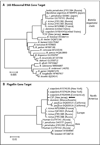Meningoencephalitis from Borrelia miyamotoi in an immunocompromised patient
- PMID: 23323900
- PMCID: PMC4018741
- DOI: 10.1056/NEJMoa1209039
Meningoencephalitis from Borrelia miyamotoi in an immunocompromised patient
Abstract
Ixodes ticks serve as vectors for Borrelia burgdorferi, the agent of Lyme disease. Globally, these ticks often concurrently harbor B. miyamotoi, a spirochete that is classified within the relapsing-fever group of spirochetes. Although humans presumably are exposed to B. miyamotoi, there are limited data suggesting disease attributable to it. We report a case of progressive mental deterioration in an older, immunocompromised patient, and even though Koch's postulates were not met, we posit B. miyamotoi as the cause, owing to its direct detection in cerebrospinal fluid (CSF) with the use of microscopy and a polymerase-chain-reaction (PCR) assay. It is likely that B. miyamotoi is an underrecognized cause of disease, especially in sites where Lyme disease is endemic.
Figures


References
-
- Barbour AG, Schrumpf ME. Polymorphisms of major surface-proteins of Borrelia burgdorferi. Zentralbl Bakteriol Mikrobiol Hyg A. 1986;263:83–91. - PubMed
-
- Berardi VP, Weeks KE, Steere AC. Serodiagnosis of early Lyme disease: analysis of IgM and IgG antibody responses by using an antibody-capture enzyme immunoassay. J Infect Dis. 1988;158:754–760. - PubMed
-
- Steere AC, Berardi VP, Weeks KE, Logigian EL, Ackermann R. Evaluation of the intrathecal antibody response to Borrelia burgdorferi as a diagnostic test for Lyme neuroborreliosis. J Infect Dis. 1990;161:1203–1209. - PubMed
-
- Molloy PJ, Berardi VP, Persing DH, Sigal LH. Detection of multiple reactive protein species by immunoblotting after recombinant outer surface protein A Lyme disease vaccination. Clin Infect Dis. 2000;31:42–47. - PubMed
Publication types
MeSH terms
Grants and funding
LinkOut - more resources
Full Text Sources
Other Literature Sources
Molecular Biology Databases
Miscellaneous
